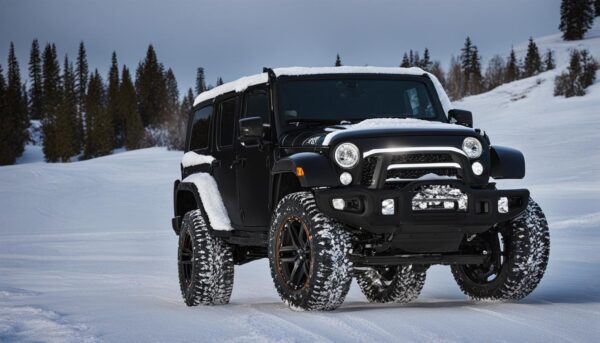Last Updated on 3 months
Unlocking the Power of Snow Tires for Consistent Traction in Every Season
When winter arrives and temperatures begin to plummet, driving conditions can quickly become treacherous. Snow tires, also known as winter tires, offer unmatched traction in various adverse driving conditions, such as heavy snowfall, black ice, and temperatures below 45 degrees Fahrenheit. Their unique engineering provides substantial advantages over all-season tires, especially in proper winter conditions where roads are unpredictable.
Unlike standard tires that may stiffen and lose grip in extreme cold, snow tires feature specialized tread rubber that remains flexible to maintain road grip. This flexibility prevents snow buildup, with deeper tread depths for more effective snow traction. Additionally, to maximize grip on ice, snow tires incorporate increased numbers of biting edges and high sipe densities, which are small slits in the tread that provide extra traction power on slick surfaces. For drivers in regions with severe winter weather, snow tires are not a luxury but an essential vehicle safety component.
Key Takeaways
- Snow tires offer exceptional traction in adverse winter driving conditions, such as heavy snowfall and black ice.
- Designed with specialized tread rubber, snow tires remain flexible in cold temperatures and maintain a grip on the road.
- Deeper tread depths and increased biting edges help prevent snow buildup and provide better traction on ice.
- For drivers in regions with severe winter weather, snow tires are necessary for vehicle safety.
- Snow tires outperform all-season tires in proper winter conditions, providing substantial advantages for improved handling and safety on icy roads.
Understanding the Versatility of All-Season Tires
All-season tires are designed to provide drivers with an option that performs reasonably well in various driving conditions. Although they cannot deliver the specialized performance of dedicated summer or winter tires, they offer a balance that appeals to many drivers. In this section, we’ll explore the factors that make all-season tires popular and their limitations in extreme weather conditions.
What Makes All-Season Tires a Popular Choice
All-season tires are commonly installed on vehicles directly from the factory. They are appreciated for their versatility and suitability for various driving conditions, including moderately wet roads and light winter driving. Their design aims to combine the benefits of both summer and winter tires, offering relatively quiet rides and extended tread life. They operate efficiently in moderate climates where extreme cold, ice, and significant snowfall are less frequent.
Some of the primary advantages of all-season tires include:
- Compatible with a variety of driving conditions
- Cost-effective solution (avoiding seasonal tire changes)
- Extended tread life
- Quieter rides compared to specialized tires
Limitations of All-Season Tires in Extreme Weather Conditions
While all-season tires provide a well-rounded solution for most drivers, they are not without their limitations, especially in extreme weather conditions. They cannot match summer tires’ powerful grip or handling precision in warm weather. Conversely, their design does not suit challenging elements such as deep snow and ice in proper winter conditions, which winter tires would better take.
All-season tires face performance compromise in specific driving conditions to achieve year-round utility. The performance restraint is likened to wearing tennis shoes year-round—sufficient for everyday situations but not optimal for specialized environments like snowy terrains.
To visualize the differences in performance, let’s compare summer, all-season, and winter tires across various aspects:
| Tire Type | Grip in Dry Conditions | Grip in Wet Conditions | Grip in Snow | Ride Comfort | Tread Life |
|---|---|---|---|---|---|
| Summer | Excellent | Very Good | Poor | Good | Average |
| All-Season | Good | Good | Average | Very Good | Very Good |
| Winter | Average | Good | Excellent | Good | Average |
In summary, all-season tires provide versatility and cost-effective solutions for many drivers. However, their performance falls short in extreme weather conditions compared to dedicated summer or winter tires. Assessing your region’s typical weather patterns and driving conditions is crucial before deciding which tire type to choose.
The Engineering Behind Winter Tires for Optimal Performance
Winter tires are designed to deliver sustained performance in harsh winter driving conditions. Their unique combination of tread rubber compounds, deeper tread depths, and distinct tread patterns set them apart from other tire types. These features work in concert to expel water and provide the necessary grip on slippery, snow-covered roads.
One cutting-edge example of tire technology is Bridgestone’s proprietary multi-cell compound, found in their Blizzak winter tires. This innovative compound tackles the issue of the thin layer of water that forms on ice, thereby enhancing traction and vehicle control in severe winter conditions.
“Bridgestone’s proprietary multi-cell compound present in Blizzak tires introduces advanced mechanisms to cope with the thin layer of water on ice, thereby enhancing traction and vehicle control in harsh winter conditions.”
Key Features of Winter Tires Engineering
- Tread Rubber Compounds: Formulated to remain flexible at low temperatures, the tread rubber compounds help maintain grip and traction, even on icy roads.
- Deeper Tread Depths: These promote enhanced snow traction, allowing for better handling and control when driving on snow-covered streets.
- Distinct Tread Patterns: Specifically designed to expel water, these patterns offer improved grip and contact on wet and slippery roadsides.
| Feature | Description | Benefits |
|---|---|---|
| Tread Rubber Compounds | Flexibility in cold temperatures | Increased road grip and traction |
| Deeper Tread Depths | Extra space for snow traction | Improved handling and control |
| Distinct Tread Patterns | Assistance in water expulsion | Better hold on wet and snowy roads |
In conclusion, the engineering behind winter tires contributes significantly to driving safety and performance during the year’s coldest months. With the right combination of tread rubber compounds, tread depths, and tread patterns, winter tires offer unparalleled grip and control on icy, slippery roads.
Distinct Features of Snow Tires That Enhance Winter Driving
Snow tires have been meticulously designed to overcome the challenges that winter weather presents for drivers. These specialty tires have distinct features that set them apart from standard all-season tires, such as specialized tread rubber, biting edges, and sipes.
The Role of Tread Rubber in Cold Weather Traction
One key factor in snow tires’ superior performance is the specially formulated tread rubber. In contrast to the compounds used in summer or all-season tires, this flexible tread rubber does not stiffen when temperatures plummet. By maintaining flexibility, the tread rubber can provide adequate traction on icy roads and enable safer navigation during harsh winter conditions.
Flexible tread rubber ensures sufficient traction on icy roads, contributing to safer winter driving.
Biting Edges and Sipes: Maximizing Grip on Icy Surfaces
Snow tires also feature biting edges and high sipe densities, which are crucial for gripping icy surfaces. Sipes are the tiny slits in the tread that serve to enhance the handling of winter tires by providing additional traction when driving on slippery roads.
| Feature | Description | Benefit |
|---|---|---|
| Tread Rubber | Flexible compound designed for cold temperatures | Improved traction on icy surfaces |
| Biting Edges | Sharp protrusions in the tire tread | Increased grip on snow and ice |
| Sipes | Tiny slits in the tread pattern | Enhanced handling and traction on slippery roads |
These design elements work together to disperse water and snow, ensuring the tire maintains contact with the road surface and reducing the risk of skidding or losing control. As a result, drivers equipped with snow tires enjoy a safer and more reliable winter driving experience.
Snow Tires vs All Season Tires: Making the Right Choice for Your Vehicle

Choosing between snow and all-season tires requires assessing typical winter driving conditions. For drivers who experience minimal snow and ice, all-season tires may suffice. However, in areas where winter means a consistent stretch of icy roads and snowfall, snow tires become a vital precaution for safety.
Evaluating Your Winter Weather Conditions
To determine the right choice for your vehicle, consider the severity and frequency of winter weather in your area. Factors to consider are average snowfall, how often temperatures drop below freezing, and the likelihood of encountering ice or slush on the road. All-season tires might be suitable if your region experiences mild winters with only occasional snow or ice. On the other hand, investing in dedicated snow tires is essential for optimal safety and performance if winter brings frequent heavy snowfalls or icy conditions.
Why a Full Set of Snow Tires is Critical for Winter Safety
Using a complete set of snow tires is crucial for improving your vehicle’s handling and stability during winter. Installing only a partial set can lead to an imbalance in vehicle handling, increasing the probability of skidding.
For example, only equipping the front tires on a front-wheel-drive vehicle with snow tires may cause the rear tires to skid, and vice versa.
A complete set of snow tires is essential to maintain control and promote even wear. When the season changes, it is also important to revert to all-season tires to prevent premature wear of snow tires on dry pavement.
- Assess your typical winter driving conditions. Understanding the severity of the weather in your area is crucial to making the right tire choice.
- Consider your vehicle type and tire requirements – Different vehicles may have specific tire needs, so consult your owner’s manual or a trusted mechanic for guidance.
- Invest in a complete set of snow tires for winter safety. This ensures balanced vehicle handling and stability.
- Switch back to all-season tires when the season changes – To prolong the lifespan of your snow tires, revert to all-season tires when winter is over.
In conclusion, carefully evaluating your winter weather conditions and understanding the capabilities of snow tires versus all-season tires will help you make the right choice for your vehicle and ensure a safer, more reliable driving experience during the winter months.
When to Invest in Snow Tires for Cars
Investing in snow tires before winter arrives is crucial to ensure maximum vehicle safety and adaptability to harsh weather conditions. Switching to snow tires is recommended when temperatures consistently fall below 45 degrees Fahrenheit. Making this change even before the first snowfall will help avoid hazardous driving conditions without adequately prepared tires.
To maintain optimal tire performance and safety, drivers should regularly check their tire pressure and have seasonal tire changes performed by professionals. Timely checks and maintenance guarantee a secure and controlled driving experience for the upcoming season.
Remember, investing in snow tires early, before the arrival of winter weather conditions, is the key to ensuring safe and secure driving throughout the cold months.
Some crucial steps to maintain tire performance and safety include:
- Keeping track of temperatures: Keep an eye on the weather, switching to snow tires once temperatures consistently drop below 45 degrees Fahrenheit.
- Seeking professional help: Have trusted professionals perform seasonal tire changes to ensure the process is completed accurately and securely.
- Regular tire pressure checks: Frequently inspect the tire pressure to safeguard sustained tire performance and safety.
By following these steps, drivers will be better prepared to navigate winter conditions with confidence and ease.
Best Snow Tires: Evaluating Snow Tire Reviews and Recommendations
Finding the best snow tires for your vehicle involves evaluating expert reviews and recommendations tailored to your vehicle type, whether an SUV or a sedan. The right fit ensures proper handling and safety during winter driving.
Finding the Best Fit: Snow Tires for SUVs and Sedans
Consumers can explore product-level tire technology details, such as Bridgestone Blizzak for SUVs, which support confident driving in snowy and icy conditions. To start searching for the ideal snow tires, consult reputable sources, such as Consumer Reports, tire brand websites, and automotive blogs, to gain insights on the top-rated snow tires for your vehicle type.
Remember: A perfect fit is essential for maximizing the performance of snow tires, ultimately enhancing safety and vehicle control on slippery roads.
Consider the following factors when selecting the best-fit snow tires for your vehicle:
- Vehicle type (SUV, sedan, truck, etc.)
- Winter driving conditions (heavy snow, ice, slush, etc.)
- Rim size and tire dimensions
- Your driving habits and needs
Once you have gathered a list of suitable snow tires, further narrow the options by comparing each performance. A detailed comparison can be made using the table format, as shown below:
| Snow Tire Model | Tread Depth | Rubber Compound | Biting Edges and Sipes | User Reviews |
|---|---|---|---|---|
| Bridgestone Blizzak | Deep | Specialized for cold temperatures | High sipe density | Excellent grip and handling |
| Michelin X-Ice | Deep | Flexible in the cold | Increased biting edges | Great performance on ice |
| Goodyear WinterCommand | Deep | Evaluated for cold weather | High sipe density | Well-suited for snowy conditions |
Expert recommendations should serve as a starting point, not a definitive decision-maker. Ultimately, individual requirements and local driving conditions should be factored into your choice of snow tires for a safer and more enjoyable winter driving experience.
All Season Snow Tires: Do They Exist?
While searching for the perfect set of tires, you might have encountered a term called “all-season snow tires” and wondered about their existence. The simple answer is that they do not exist. The notion of all-season snow tires reflects an attempt to blend the features of both all-season and winter tires. However, it is essential to understand that all-season and snow tires fundamentally differ in their performance in winter weather conditions.
All-season tires may carry the M+S (mud and snow) rating but should not be confused with dedicated winter tires with a snowflake symbol. While advancements in tire technology have made all-season tires suitable for various driving conditions, they cannot match the performance of winter tires in severe snow and icy conditions.
A tire designed to excel in severe winter conditions requires specific engineering and technologies that may compromise its performance in other seasons. On the other hand, all-season tires are built to maintain an acceptable level of performance across a wide range of conditions, including moderately wet roads and light winter driving. However, their compromise in design makes them less effective in heavy snow and icy conditions than dedicated snow tires.
| Tire Type | Performance in Winter Conditions |
|---|---|
| All-season tires | Average performance in light snow and moderate winter conditions |
| Winter tires | Superior performance in heavy snow and extreme winter conditions |
“While it’s true that all-season tires are designed for year-round use, they simply cannot match the traction and performance of dedicated winter tires in severe snow and ice.”
When selecting a tire for your vehicle, it is crucial to consider the typical winter weather conditions you’ll face and evaluate whether a set of dedicated winter tires is necessary for your safety and the optimal performance of your vehicle.
Prepping for Winter: A Step-by-Step Snow Tires Buying Guide

Choosing the right snow tires for your vehicle is crucial for staying safe in harsh winter conditions. This guide will walk you through the different considerations and steps in making the best choice for your needs.
- Assess your winter driving conditions and vehicle type: Determine the severity of winter weather in your area and consider whether your vehicle is an SUV or sedan. This will help you better understand the need for dedicated snow tires.
- Choose the correct size: To find the appropriate tire size for your car, consult your vehicle’s owner’s manual or the tire placard on the driver’s side door jamb.
- Understand tread and rubber compound technology: Familiarize yourself with key features of snow tires, such as deeper tread depths and flexible rubber compounds that improve traction on icy roads.
- Compare snow tire options: Review expert recommendations and weigh the pros and cons of various snow tire brands to make an informed decision.
- Select a trusted retailer or service provider for installation: Ensure professional installation of your chosen snow tires for optimum winter driving safety.
By following these steps and considering the abovementioned essential factors, you can confidently choose the right snow tires for your vehicle and personal needs.
As you compare different snow tire options, consider using the following table to guide your decision:
| Tire Brand | Expert Rating | Key Features |
|---|---|---|
| Bridgestone Blizzak | 4.6/5 | Flexible tread rubber, multi-cell compound, top-tier ice traction |
| Michelin X-Ice | 4.7/5 | Excellent wet grip, long tread life, eco-focused technology |
| Continental WinterContact | 4.5/5 | Superb handling, hydroplaning resistance, responsive steering |
| Goodyear Ultra Grip | 4.4/5 | Confident handling, impressive wet traction, quiet ride |
Remember, the selection of snow tires should be based on your specific needs and vehicle type, prioritizing safety and performance for optimal winter driving. Always follow the manufacturer’s recommendations and consult professionals to install and maintain your snow tires.
Maximizing Your Snow Tires’ Lifespan and Performance
Engaging in regular maintenance activities is crucial to ensuring the best performance and longest life for your snow tires. These include monitoring the tire’s tread depth, storing them properly during off-seasons, investing in a complete set of winter wheels, and keeping up with tire rotations, balancing, and alignment checks. By understanding and practicing these key strategies, you can extend the life and effectiveness of your snow tires, ultimately contributing to a smoother and safer winter driving experience.
Regularly checking the tread depth on your snow tires is essential for maintaining their safety and effectiveness. As a rule of thumb, snow tires should have a minimum tread depth of 6/32nds of an inch to maintain proper traction in winter conditions. Drivers can use a tread depth gauge or a penny to measure tread depth. Place the penny with Lincoln’s head facing downward; if the top of his head is visible, it’s time to replace the tires.
Proper Storage
Storing your snow tires correctly during the off-season is another crucial strategy for maximizing lifespan. Off-season storage should avoid extreme heat or sunlight, as these elements can degrade the tire’s rubber compounds. Consider a climate-controlled environment like a garage or basement to ensure your snow tires remain in good condition.
Pro Tip: Invest in a full set of winter wheels for easier seasonal switching without incurring the high costs of remounting each year.
Regular Tire Maintenance
Regular tire rotations, balancing, and alignment checks will enhance your snow tires’ performance and contribute to a smoother and safer driving experience. Consider rotating them every 6,000 to 8,000 miles to maintain even wear across all tires. Be sure to have your tires balanced and wheel alignment checked at least once a year according to your vehicle manufacturer’s recommendations.
- Monitor tread depth regularly to ensure safety and effectiveness.
- Store snow tires in a climate-controlled environment free from extreme heat or sunlight.
- Invest in a complete set of winter wheels for easier seasonal switching.
- Per your vehicle manufacturer’s recommendations, perform regular tire rotations, balancing, and alignment checks.
Conclusion
Snow tires offer a vital advantage for drivers facing harsh winter conditions, providing superior traction, handling, and safety compared to all-season tires. When selecting the appropriate tires for your vehicle, it is crucial to evaluate your typical winter driving conditions and ensure a complete set of snow tires is installed for optimal safety and performance.
Regular maintenance, including monitoring tread depth and proper off-season storage, can maintain snow tires’ longevity and effectiveness. Additionally, investing in a complete set of winter wheels will facilitate easier seasonal transitions and reduce the costs associated with tire remounting each year.
Ultimately, staying informed about the capabilities and limitations of different tire types will help drivers make educated decisions to ensure a safer and more reliable driving experience throughout the winter months. Investing in snow tires is a wise decision for those living in severe winter climates and a crucial factor in promoting vehicle safety during challenging weather conditions.
FAQ
What makes all-season tires a popular choice?
All-season tires are famous for their versatility and suitability for various driving conditions, including moderately wet roads and light winter driving. Their design aims to combine the benefits of both summer and winter tires, offering relatively quiet rides and extended tread life. They are commonly installed on vehicles directly from the factory.
What are the limitations of all-season tires in extreme weather conditions?
The performance of all-season tires in proper winter conditions is not comparable to that of specialized winter tires. They face performance compromises in specific driving conditions to achieve year-round utility, making them less suitable for handling deep snow and ice, which would be better handled by winter tires.
What are the distinct features of snow tires that enhance winter driving?
Snow tires feature specialized tread rubber that remains flexible in cold temperatures and helps maintain road grip. They also have deeper tread depths and unique tread patterns that assist in expelling water and providing the necessary grip on snow-covered roads. Additionally, snow tires incorporate increased numbers of biting edges and high sipe densities to maximize grip on ice.
How do I choose between snow tires and all-season tires for my vehicle?
Choosing between snow and all-season tires requires assessing your typical winter driving conditions. If you experience minimal snow and ice, all-season tires may suffice. However, in areas where winter means a consistent stretch of icy roads and snowfall, snow tires become a vital precaution for safety. A complete set of snow tires is recommended to ensure balanced vehicle handling in winter conditions.
When is the best time to invest in snow tires for cars?
The best time to invest in snow tires is before the arrival of winter weather conditions. Switch to snow tires when temperatures consistently fall below 45 degrees Fahrenheit, even before the first snowfall, to avoid hazardous driving conditions without adequate tire readiness. Professionals should perform Seasonal tire changes, and your tire pressure should be regularly checked to maintain performance and safety.
How do I find the best snow tires for my vehicle?
Evaluate expert reviews and recommendations tailored to your vehicle type, whether an SUV or a sedan. Consider product-level tire technology details, like Bridgestone Blizzak for SUVs, which support confident driving in snowy and icy conditions. Select a trusted retailer or service provider for professional installation to find the best snow tires for your vehicle.
Do all-season snow tires exist?
While all-season tires may be marked with M+S (mud and snow), they should not be confused with dedicated winter tires adorned with a snowflake symbol. The notion of all-season snow tires reflects an attempt to blend the features of both all-season and winter tires. However, all-season tires will not match the performance of winter tires in severe snow and ice.
How can I maximize the lifespan and performance of my snow tires?
To maximize the lifespan and performance of snow tires, engage in regular maintenance, including monitoring tread depth, proper storage during off-seasons, and investing in a complete set of winter wheels for easier seasonal switching. Routine tire rotations, balancing, and alignment checks will enhance performance and create a smoother and safer driving experience.












